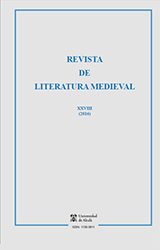«La intensificació retòrica del elements morbosos en les faules mitològiques de Joan Roís de Corella: de la imitatio a la innovació estètica»
DOI:
https://doi.org/10.37536/RLM.2016.28.0.62049Resumen
Resumen: Les faules mitològiques, amb les quals Roís de Corella inicia la seua carrera literària, són exercicis escolars destinats a l’ensinistrament en l’escriptura en prosa. Cadascun d’aquests textos reescriu, amb trets originals, un tema ja tractat anteriorment per autors prestigiosos. Una de les innovacions que hi aporta Roís de Corella és l’amplificació retòrica de les seqüències més morboses d’aquestes faules, dins d’una proposta estètica caracteritzada per l’exacerbació sentimental i l’efectisme. Així es dedueix de l’acarament d’algunes de les seqüències més tràgiques d’una selecció d’aquests relats (el Plant dolorós de la reina Hècuba, la lletra de Medea, la lamentació de Mirra i les històries de Pasífae i de Tereu, Procne i Filomela) amb els models literaris corresponents.
Paraules clau: Roís de Corella, faules mitològiques, elements morbosos, intensificació retòrica, models literaris.
«Rhetoric intensification of morbid elements in the mythological tales by Joan Roís de Corella: from the imitatio to the aesthetic innovation»
Abstract: The mythological tales, with whom Roís de Corella began his literary career, are school exercises for training in prose writing. Each of these texts is dedicated to rewrites, with original features, a subject previously dealt by prestigious authors. One of the innovations that Roís de Corella offers is a rhetorical amplification of the more ghoulish sequences of these fables, in an aesthetic proposal characterized by sentimental exacerbation and sensationalism. This is deduced from the comparison between some of the most tragic sequences of a selection of these short stories (the Plant dolorós de la reina Hècuba, Medea letter, lamentation of Mirra and the stories of Pasífae and Tereu and of Procne and Filomela) with their corresponding literary models.
Keywords: Roís de Corella, mythological tales, ghoulish elements, intensifying rhetoric, literary models.
Descargas
Métricas alternativas
Descargas
Cómo citar
Número
Sección
Licencia
Las opiniones y hechos consignados en cada artículo son de exclusiva responsabilidad de sus autores. La Universidad de Alcalá no se hace responsable, en ningún caso, de la credibilidad y autenticidad de los trabajos.
Los autores conservan los derechos sobre sus trabajos, aunque ceden de forma no exclusiva los derechos de explotación (reproducción, edición, distribución, comunicación pública y exhibición) a la revista. Los autores son, por lo tanto, libres de hacer acuerdos contractuales adicionales independientes para la distribución no exclusiva de la versión de la obra publicada en la revista (por ejemplo, alojarlo en un repositorio institucional o publicarlo en un libro), siempre que medie un reconocimiento de su publicación inicial en esta revista.
Los trabajos se publican bajo los términos estipulados en la Licencia de Atribución-NoComercial-CompartirIgual 4.0 Internacional Creative Commons (CC BY-NC-SA 4.0) que permite a terceros compartir la obra bajo las siguientes condiciones:
Atribución — Usted debe dar crédito de manera adecuada, brindar un enlace a la licencia, e indicar si se han realizado cambios. Puede hacerlo en cualquier forma razonable, pero no de forma tal que sugiera que usted o su uso tienen el apoyo de la licenciante.
NoComercial — Usted no puede hacer uso del material con propósitos comerciales.
CompartirIgual — Si remezcla, transforma o crea a partir del material, debe distribuir su contribución bajo la misma licencia del original.









